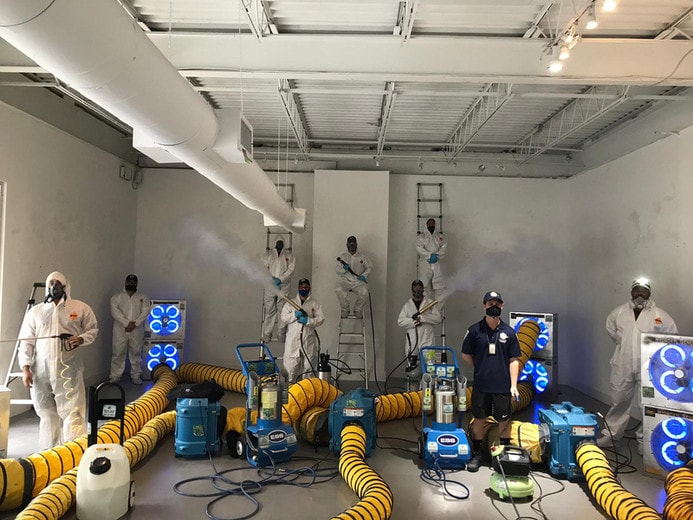
A General Guide to a Comprehensive Mold Assessment, Mold Testing, and Mold Removal Project
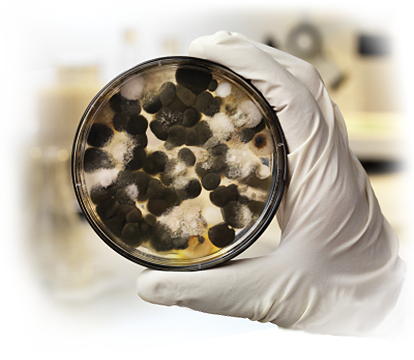
Mold is commonly found in almost all homes, at one point or another, and is almost always associated with water, humidity, poor ventilation, dampness, and flooding. Mold only needs oxygen, organic material, and water to grow. Mold can be found in many color hues like green, brown, grey, and black, and reproduces by releasing spores. As mold releases it’s spores and VOC’s into the air, it can causes health issues and allergic reactions through contact and inhalation. Mold exposure can also be linked to a variety of health problems like eye infections, respiratory issues, rashes, allergic reactions, etc.
Essentially mold is a type of fungus that can grow, reproduce, and literally take over a home or building within 2-3 days of the initial infestation. The spores found in mold travel through the air and herein lay the health risks associated with mold. Beware of black mold as it is toxic and can cause serious health complications.
Types of Mold
The different types of mold commonly found in and around homes, apartment buildings, condos, office buildings, warehouses, etc
-Aspergillus is the one of the more common forms of mold and is found in the air we breathe. While typically not harmful, this type of mold can cause health issues for people with weakened immune systems.
– Cladosporium is usually found growing on organic material. It is typically green or black and although in most cases non-toxic to humans, it is associated with allergic reactions, asthma, and even infections.
– Stachybotrys- Toxic black mold appears very similar in nature to Cladosporium, except that it is usually slimy due to the wet layer on top. It can appear dry and powdery as with Cladosporium if their water source has dried up. This mold is extremely hazardous to humans and the mycotoxins found in black mold causes a variety of serious health issues like dizziness, mental impairment, nausea, irritation of the mucous membranes, infections, and many other forms of serious health complications.
Now that we have identified a few of the types of mold that can occur inside your home or building, it is imperative to understand what mold requires to grow and thrive.
Requirements for mold growth
- Mold grows in dark and damp areas of your home. Typical areas will include attics, basements, kitchens, crawlspaces, inside of your walls, bathrooms, on foundations…
- Mold’s main partner in growth is moisture. Areas that are showing water leaks like plumbing, toilets, ceilings and behind painted surfaces are ideal for moisture to seep through.
- Humidity is also associated with mold growth. That familiar stuffy atmosphere when you walk into a dark room with a high humid content is ideal for mold growth.
- Mold needs oxygen to grow as with all living things.
- Mold needs heat to grow and cannot survive in extremely cold temperatures.
- Mold needs a surface to grow and feed on. Mold will grow and just about any organic material; wood, cotton, drywall, clothing, leather, etc.
- The last thing that will cause mold to thrive is if it is given sufficient time to grow in prime conditions.
A combination of the above will cause mold to grow and flourish in and around your home . The next phase is to identify and then inspect the areas where mold growth usually occurs.
Where to find mold
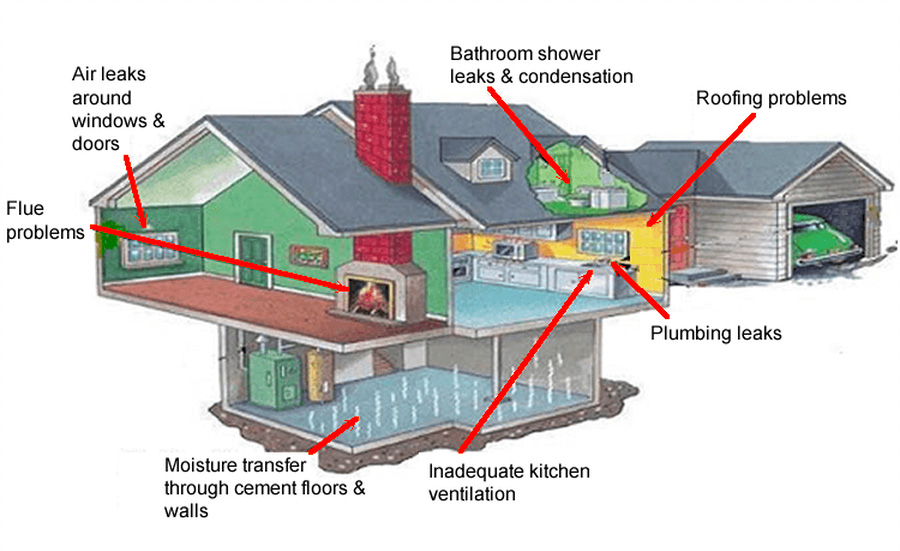
Listed below are some common places you will find mold in and around your home-
- Ceilings are a common area for mold to grow. If the area is painted, you can usually just wipe it away, but if it is unpainted, you will most probably have to cut that area out as mold grows in its food source like hardboard. If you see water damage on the ceiling, chances are you will also see signs of mold, along with signs of a water leak or moisture problem. If you can see it from the bottom, then imagine the colony of mold inside your ceiling.
- Windows and window frames are also common areas for mold growth due to condensation and dirt accumulating against the glass and then rolling down onto the frame.
- Drywall is another common area for mold growth due to its high cellulose content. Should you find mold growth on drywall you will more than likely have to cut out the area where the infection is, find and fix the source of moisture intrusion, remove the mold, and repair the area.
- Walls are perfect growth areas for mold due to condensation. On a non-porous wall, you can only wipe it away, but on an unpainted porous wall, you will have to cut out the infected area. Mold also grows inside walls where cavities are created containing humid and moist air. Check for peeling paint or water damage against the wall. Allergic reactions when entering a specific room is usually a good indication of growth.
- Basements and attics are ideal areas for mold growth because they are usually dark, stuffy, warm, have poor ventilation, and are high in humidity. If there was a massive rainstorm and your basement was flooded, rest assured you will be dealing with mold.
- Mold can grow under your floors as well. Usually caused from leaks, floods, and leaky HVAC systems.
- Clothes can get mold growth if it was left wet over a long period.
- Kitchens are prime targets for mold to grow. Leaving dishes unwashed, allowing food like bread to go stale, leaving food items at the bottom of the fridge, the cupboard under the sink where the plumbing runs through and other areas are ideal for mold growth. Ensure hygiene is prime.
- Bathrooms are another prime target because there is always water, moisture, and humidity to be found. Leaky pipes, behind the toilet, under the vanity cupboard, on and inside walls, and the shower are prime places within your bathroom for mold.
If you have a moldy smell in a specific area, or notice an increase in allergic reactions, other related mold symptoms, or if you have a water leak or leaky roof, the possibility of mold is almost certain.
Give us a call to schedule a mold assessment today- 1-305-763-8070
The Mold Inspection Process
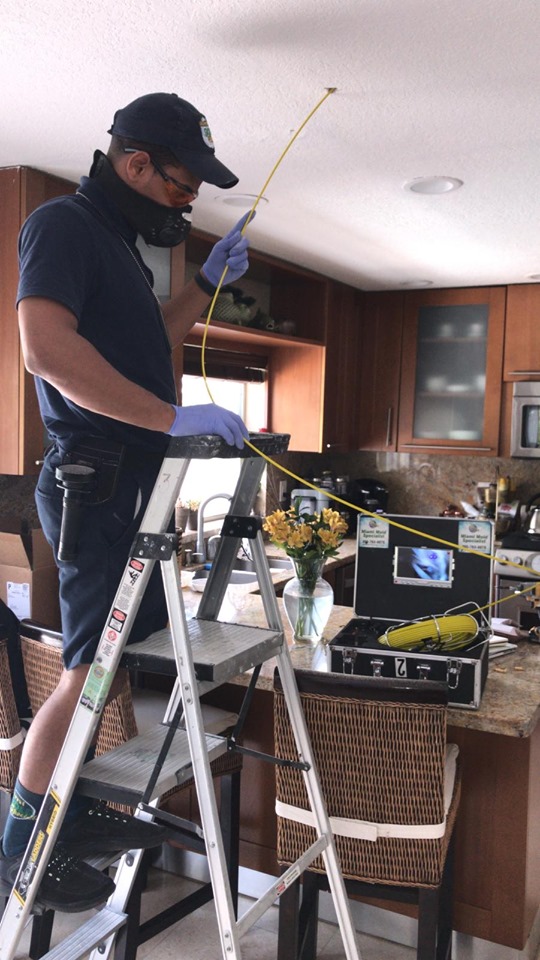
If you suspect you have mold in your home, it is best to perform a thorough mold inspection. A comprehensive mold inspection aims to confirm or set at ease your fears of mold growth, to find the cause, and usually the water source, causing such mold growth.
Even if you know you have mold, you should still get a professional to perform a thorough inspection of your home. When you can see the mold there is a great chance that there is more mold growing somewhere out of sight. These specialists have the right equipment to inspect for the existence of mold. An inspection follows the following route:
- Inform the mold specialist of any past or recent water problems you might have had. Think of all areas there might have been a water problem like leaking pipes or walls that are starting to bulge and peel. This way they can get started at those areas specifically where you mentioned water damage and mold exist. The Miami mold inspection specialist will ask you pertinent questions to gather the required information in any case.
- Every single area that is prone to water must be inspected like bathrooms, kitchens, and basements. If water leaks are found, even if you conduct your own inspection, this will often lead you to where the mold is growing.
- If mold is not found in a room, this does not necessarily mean there is no mold. Mold has the knack to grow in unseen places like behind walls in cavities hidden away from sight.
- When mold is found and you can see it is indeed mold, try not to disturb it unless it is a common mold that can be easily removed and was formed during normal condensation processes. If you do disturb and try to remove it, you might be missing the larger growth. Leave it to the specialist to test in any case and to determine the true source.
- The water /moisture source needs to be found after identification of mold. What is the point in remediation if the original water leak is not fixed during this process? In cleaning the mold, you will most probably cause the spores to move through the air and cause health risks and finds another place to grow. hence another good reason to leave it to the professionals.
Give us a call to schedule a mold assessment today- 1-305-763-8070
The Mold Testing Process

Miami Mold Testing Services
Mold tests are used in determining a variety of aspects. They are especially beneficial where a physical mold inspection did not show any signs of mold but you could still smell it.
- Test samples of the mold to identify the type of mold that exists;
- Assist in identifying the type of mold, if it is toxic, which helps the mold removal specialists understand the exact processes and cleaning products to be used when removing the specific type of mold.
- It measures indoor air quality by taking an air sample and analyzing it for spores.
There are various types of mold testing kits available where you can collect the mold samples. If the substance is identified as mold by your kit, you send it the laboratory, which will identify the type of mold. There are usually two tests – one for testing the substance and another for testing the air quality. This is then sent to a lab for further inspection and you receive a mycology report. There are however, downsides to using these kits.
As beneficial as these a DIY test may sound, it is always a good idea to involve a mold specialist in this process. They will collect the samples, test the air, get results, and test for moisture levels using specialized equipment and gathering tools. The reasons for mold testing are:
- When you have noticed signs of mold or that tell tale stuffy moldy smell
- Measurement of the indoor air quality is important to find how many spores are in the air. At different times, these will differ, but your specialist should consider this.
- Identify the type(s) of mold
- Mold testing data used to formulate an effective mold remediation plan.
- To confirm whether all the mold has been removed afterwards.
Give us a call to schedule a mold test today- 1-305-763-8070
Mold Remediation

Miami Mold Removal Services
After all the steps above have been taken and the cause of the problem has been fixed, it is time for mold remediation or then the mold removal process can take place. It is always best to get a mold specialist to conduct the mold remediation process, especially if it is more than 10 sq.ft. worth of area. Mold remediation follows a specific process and steps that need to be taken until your house is finally free from mold.
- Before even starting to clean or remove mold, it is highly advised to wear personal protective equipment before you do anything else. Ensure you have goggles, dust mask, gloves and a body suit and get dressed. Remember earlier it was stated that spores travel through the air?
- Seal off the rooms if you are going to remove large quantities of mold to prevent the spores from spreading to the rest of the house. Seal every opening you can find to prevent the spores from escaping.
- Ensure that you dampen dry mold because as soon as you remove them they will release spores into the air. Always ensure that heating and cooling systems are turned off before removal.
- Use a solution to remove the mold from the area. If you hired a specialist, they have the right solutions to effectively kill and remove mold. Many household cleaners will also do a similar job like vinegar, bleach and ammonia.
- Where an area needs to be removed because the mold grew inside, ensure that when removing the affected area that it does not contaminate other areas.
- A specialist will use a mold killing solution to kill spores that are in the sealed off area to prevent them from turning into mold later.
- After the area has dried and all the spores killed, the specialist must vacuum the sealed off area with a dry vacuum cleaner. This will remove all the extra spores and mold.
- Discard the entire residue like moldy items and the vacuum bag by placing it in bags and sealing it properly before you mark the area as clean. If possible, do not work through the house with these bags but pass it through a window or nearest exit.
- Inspect the room after remediation and compare to the initial inspection results to ensure that there is no mold present any longer.
- Only after inspection, can you unseal the room and move on to the next area that is contaminated.
As you can see the entire mold remediation process, when completed properly, can take a substantial amount of time, effort, and money to eradicate.
Mold can cause major health issues and aesthetically it is ugly to look at, and it smells horrible in any case. Hire a Miami mold removal specialist that has the necessary knowledge, expertise, equipment, technology, and experience to conduct this kind of hazardous work properly.
Give us a call to schedule a mold assessment today- 1-305-763-8070
About Our Mold Removal/Remediation Company in Miami
About Miami Mold Specialists:
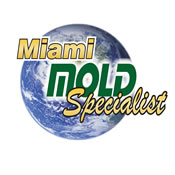
Miami Mold Specialists is a State of FL Multi-Certified Mold Removal Company based out of Miami, FL, servicing clients in NYC and South Florida for over 3 decades. Providing mold assessments, mold testing, and mold removal services by utilizing up to date techniques, state of the art equipment, and cutting edge science to completely exterminate mold from any residential, commercial, industrial, or institutional building(s).
Simply give us a call to schedule a consultation- 1-305-763-8070
https://miamimoldspecialists.com/contact-us/







